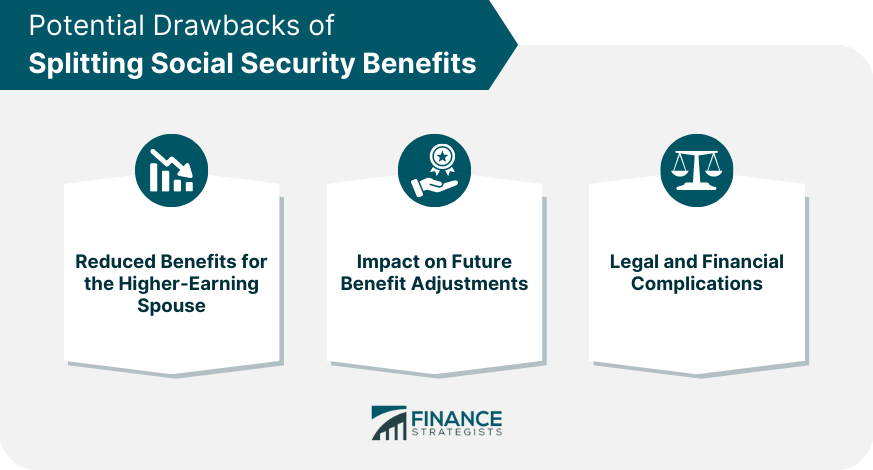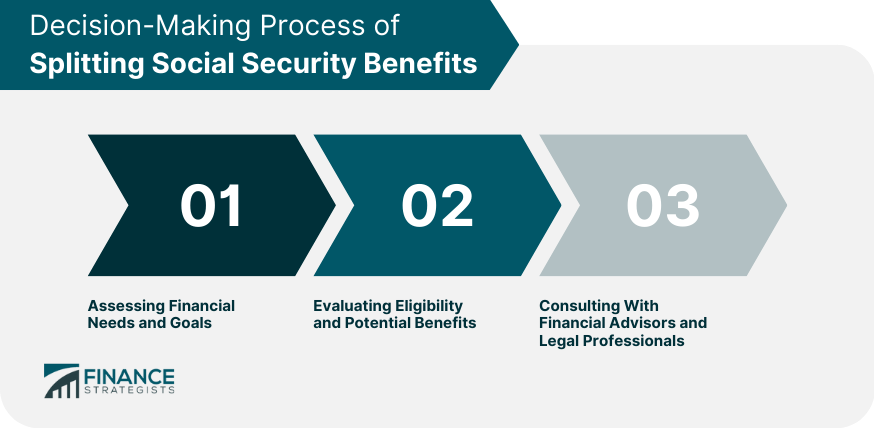Social Security benefits are a crucial source of income for many retirees in the United States. These benefits, which are funded through payroll taxes, provide financial support for retired workers, disabled individuals, and their dependents. One aspect of Social Security that often raises questions is the splitting of benefits, particularly in cases of divorce or marriage. Splitting Social Security benefits, also known as spousal benefits, is a feature of the Social Security program that allows married couples to share their retirement benefits. When one spouse files for Social Security retirement benefits, the other spouse may be eligible to receive a portion of their benefit amount, even if they have not worked or paid into the Social Security system themselves. To be eligible for spousal benefits, the couple must be legally married and the spouse receiving benefits must be at least 62 years old. The amount of spousal benefits that the eligible spouse can receive is generally equal to half of the primary earner's Social Security retirement benefit. Splitting Social Security benefits can be beneficial for couples where one spouse has significantly lower or no earnings history of their own. It can help provide a source of income in retirement and potentially increase the overall retirement income for the couple. It is important to note that there are rules and limitations around spousal benefits, and couples should consider their unique financial circumstances and goals before making any decisions about claiming Social Security benefits. When a couple divorces, their Social Security benefits may be affected. To be eligible for benefits based on an ex-spouse's record, certain criteria must be met: The marriage must have lasted at least 10 years. The person claiming benefits must be unmarried and at least 62 years old. The ex-spouse must be entitled to Social Security retirement or disability benefits. It is important to note that claiming benefits based on an ex-spouse's record does not reduce the benefits received by the ex-spouse or their current spouse. In the case of married couples, there are two types of benefits that may be relevant when considering the splitting of Social Security benefits: spousal benefits and survivor benefits. Spousal benefits allow one spouse to receive up to 50% of the other spouse's full retirement benefit. This can be especially helpful in cases where one spouse has a significantly lower lifetime earnings record. Survivor benefits provide financial support to a surviving spouse after the death of their partner. These benefits are generally equal to the deceased spouse's full retirement benefit, ensuring continued financial stability for the surviving spouse. There are several reasons why individuals might consider splitting their Social Security benefits: Maximizing lifetime benefits and balancing income between spouses are two primary financial considerations when splitting Social Security benefits. Couples may choose to split benefits to ensure that both partners receive a more equitable share of their combined retirement income. Individual financial goals and retirement plans can also play a role in the decision to split benefits. For example, if one spouse plans to retire early, they may decide to split their benefits to provide additional income during the early retirement years. There are various claiming strategies that couples can employ to split their Social Security benefits: One strategy involves coordinating the timing of benefit claims. By staggering when each spouse claims benefits, couples can optimize their combined retirement income. The restricted application strategy, which is only available to those born before January 2, 1954, allows individuals to claim spousal benefits while delaying their own retirement benefits. This can result in a higher personal benefit later on, due to delayed retirement credits. In some cases, couples may be able to adjust their benefit calculations through divorce decrees or court orders, or by voluntarily redistributing benefits. In some cases, the higher-earning spouse may experience a reduction in their own benefits, particularly if they are subject to a divorce decree or court order that mandates the splitting of benefits. Splitting benefits may also have an impact on future benefit adjustments, such as cost-of-living increases, which could affect the long-term financial stability of both spouses. The process of splitting Social Security benefits can involve legal and financial complications, making it essential for couples to seek professional advice and carefully consider the potential consequences of their decisions. To ensure a secure financial future, individuals should follow a structured planning and decision-making process when considering the splitting of Social Security benefits: Couples should first assess their financial needs and goals, both in the short term and the long term. This will help them determine whether splitting benefits is a viable and beneficial option. Next, individuals should evaluate their eligibility for various benefit options, as well as the potential benefits they might receive under different claiming strategies. This can help them make an informed decision about the best way to split their Social Security benefits. Before making any decisions, couples should consult with financial advisors and legal professionals who can provide guidance on the potential consequences and implications of splitting Social Security benefits. These experts can help ensure that individuals make the best possible decisions for their unique circumstances. Navigating the complexities of splitting Social Security benefits is critical for optimizing retirement income and ensuring long-term financial stability for both partners. By understanding the legal framework surrounding divorce and marriage, as well as the various reasons for splitting benefits, individuals can make well-informed decisions that align with their personal financial goals and retirement plans. Additionally, exploring different methods of splitting benefits, such as claiming strategies and benefit calculation adjustments, can help couples tailor their approach to their unique circumstances. However, it is important to be aware of the potential drawbacks and risks associated with splitting Social Security benefits, such as reduced benefits for the higher-earning spouse or the impact on future benefit adjustments. To navigate these challenges and make the best possible decisions, individuals should engage in a structured planning and decision-making process that involves assessing financial needs and goals, evaluating eligibility and potential benefits, and consulting with financial and legal advisors. In summary, splitting Social Security benefits can be a valuable strategy for couples seeking to maximize their retirement income and achieve a more equitable distribution of resources. By carefully considering all relevant factors and seeking expert guidance, couples can make informed choices that support their financial well-being throughout their retirement years.Splitting Social Security Benefits: Overview
Legal Framework for Splitting Social Security Benefits
Divorce and Social Security Benefits
Marriage and Social Security Benefits
Spousal Benefits
Survivor Benefits
Reasons for Splitting Social Security Benefits
Financial Considerations
Personal Preferences
Methods of Splitting Social Security Benefits
Claiming Strategies
Timing of Benefit Claims
Restricted Application Strategy
Benefit Calculation Adjustments
Potential Drawbacks of Splitting Social Security Benefits
Reduced Benefits for the Higher-Earning Spouse
Impact on Future Benefit Adjustments
Legal and Financial Complications

Decision-Making Process of Splitting Social Security Benefits
Assessing Financial Needs and Goals
Evaluating Eligibility and Potential Benefits
Consulting With Financial Advisors and Legal Professionals

Final Thoughts
Splitting Social Security Benefits FAQs
Splitting Social Security benefits refers to the process of dividing the benefits between two spouses in a divorce. This can allow both spouses to receive a portion of the benefits, even if one spouse did not work outside the home or did not earn as much as the other spouse.
Social Security benefits are split based on the length of the marriage and the work history of both spouses. If the marriage lasted at least 10 years and both spouses are at least 62 years old, the lower-earning spouse can receive up to 50% of the higher-earning spouse's benefit amount.
No, Social Security benefits cannot be split if the marriage lasted less than 10 years. However, the lower-earning spouse may still be eligible for benefits based on their own work history or based on the work history of a previous spouse.
If the higher-earning spouse remarries, their ex-spouse's benefits will not be affected. The lower-earning spouse can still receive a portion of the higher-earning spouse's benefits as long as the requirements for splitting benefits are met.
If the lower-earning spouse remarries, their eligibility for Social Security benefits based on their ex-spouse's work history will generally end. However, if the subsequent marriage ends in divorce or annulment, the lower-earning spouse may be eligible for benefits based on their ex-spouse's work history again.
True Tamplin is a published author, public speaker, CEO of UpDigital, and founder of Finance Strategists.
True is a Certified Educator in Personal Finance (CEPF®), author of The Handy Financial Ratios Guide, a member of the Society for Advancing Business Editing and Writing, contributes to his financial education site, Finance Strategists, and has spoken to various financial communities such as the CFA Institute, as well as university students like his Alma mater, Biola University, where he received a bachelor of science in business and data analytics.
To learn more about True, visit his personal website or view his author profiles on Amazon, Nasdaq and Forbes.













